What I’ve Been Playing (Q2) 2020
Thoughts and impressions on the games I played during the months of April thru June.
 UnexpectedGames
UnexpectedGames
Just a friendly bear who works in financial reporting that would rather be playing, writing or talking about video games. https://twitch.tv/unexpectedenemy
Thoughts and impressions on the games I played during the months of April thru June.
2020 has been an extremely challenging year. Amid a global pandemic that has no end in sight and a country that’s been in social/civil unrest (because of a wannabe dictator), it’s hard to get out of bed most days. Since March, video games continue to be one of the only remaining outlets I have while I’ve been working from home. So, here’s a bunch of words and ramblings about the games I played from April through June.
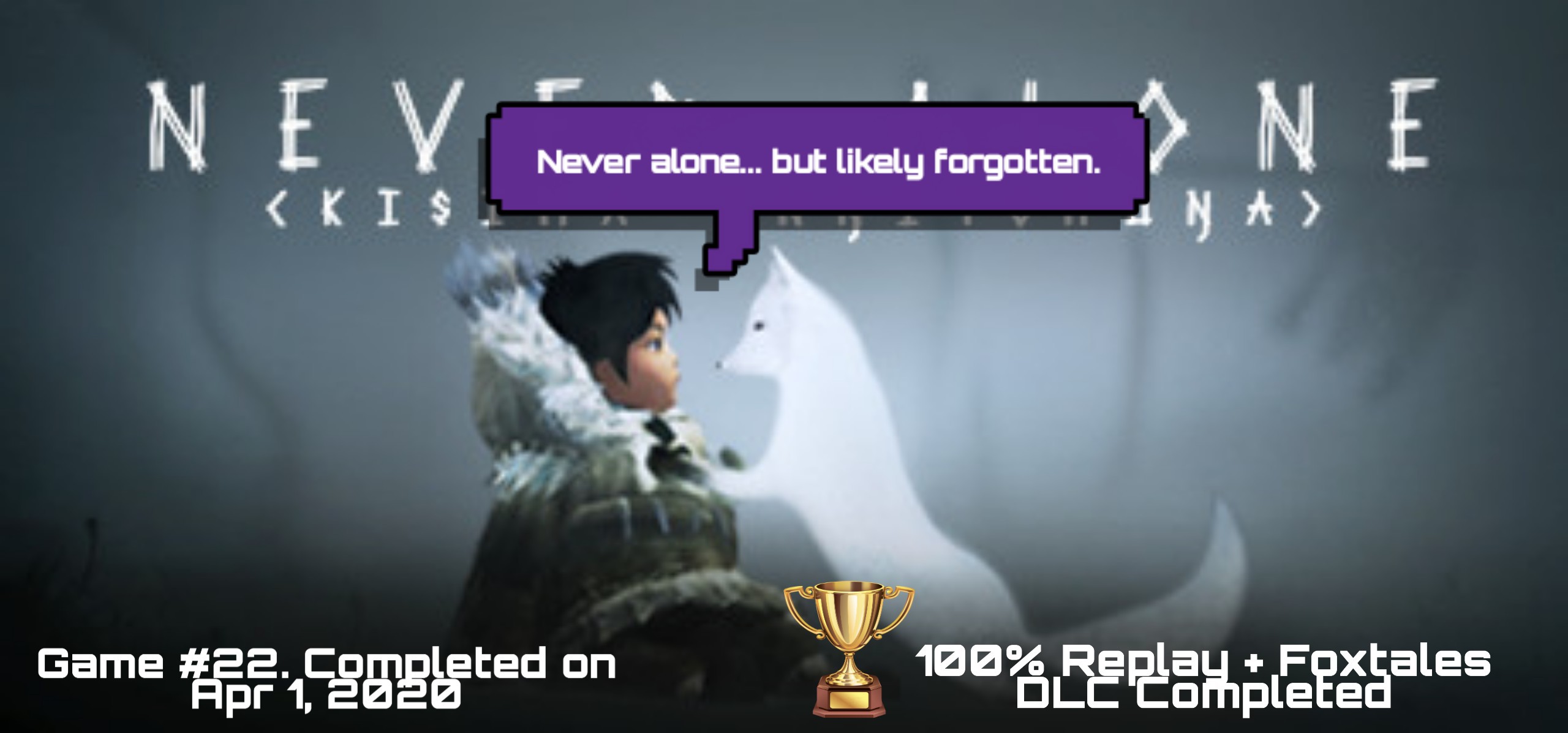
Never Alone [Kisima Ingitchuna] is a 2D puzzle-platformer developed by Upper One Games and published by E-Line Media. It’s sort of an educational-based experience that focuses on the Iñupiaq tale, “Kunuuksaayuka”, the Alaska Native culture and the harsh life of the Alaskan wilderness. You control a young girl and a fox as they set out to investigate a seamlessly never-ending blizzard that’s bombarding their village. You’ll run, jump and solve simple environmental puzzles while battling the fierce arctic winds and wildlife along the way. I completed an initial play-through years ago on the PlayStation 4 (PS4) when it first released, but I lost my save file and I never did finish the downloadable content (DLC), Fox Tales, so I figured a proper replay was due in-full.
Fox Tales, specifically, was conceptually more interesting than the base game due to its reliance on canoeing through dangerous waters. The majority of this expansion took place in underwater-based levels/sequences, which some people may not be a fan of, but it’s certainly a well-made piece of content. However, if you’re a fan of the 2D puzzle-platformer genre, there’s really nothing you haven’t seen here before. With that said, it’s still a cute and interesting game with a historical touch you won’t find elsewhere. There are even documentary-styled videos that you can unlock which teach you about the history of this tribe and the Alaskan indigenous folklore. I definitely learned a thing or two I didn’t know before.
Finally, the developer just released another new, documentary-styled game called Beyond Blue, which is about exploring the ocean and the impact industrialization has had on the the depths of our waters (which I finished recently and will write about in my next post, so stay tuned).
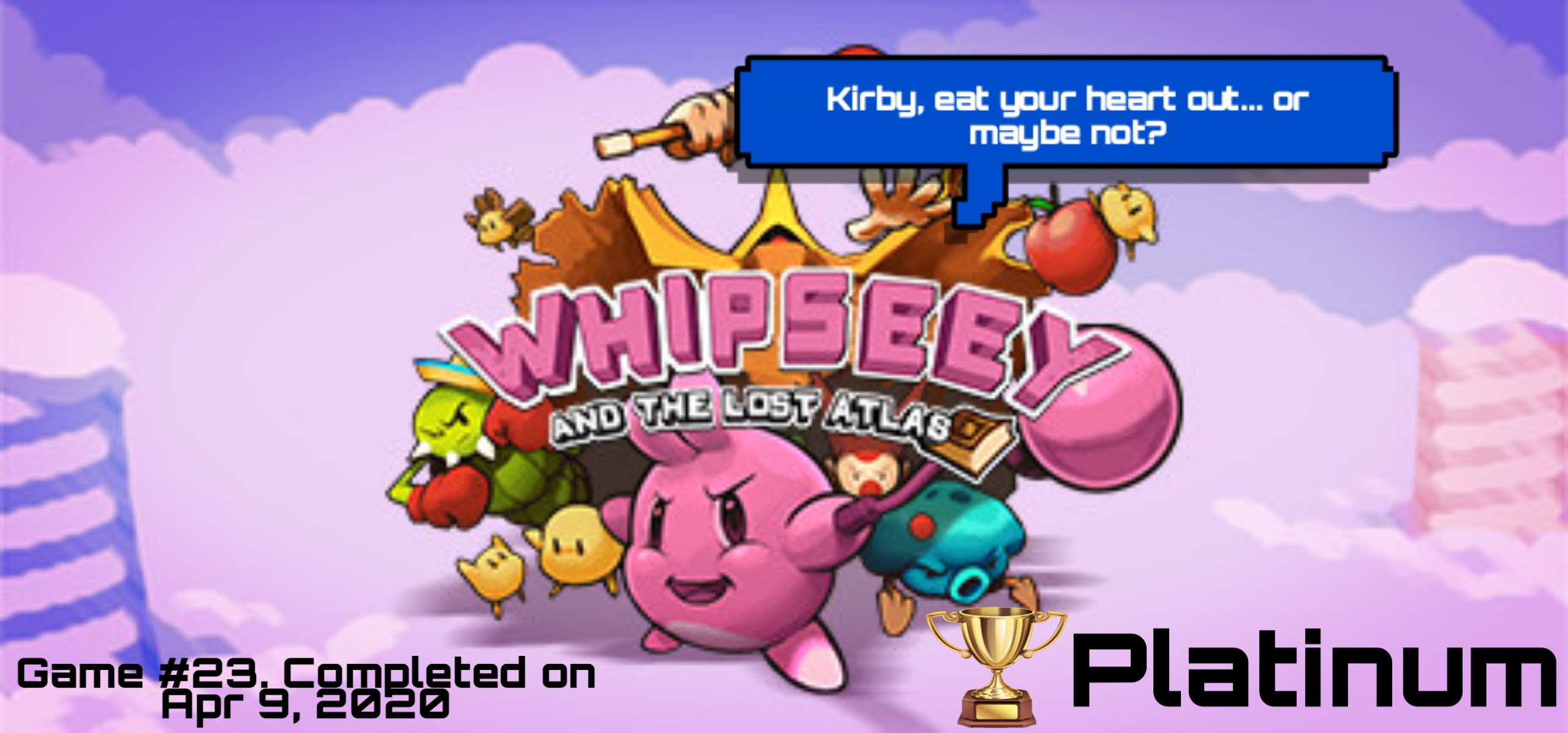
Whipseey and the Lost Atlas, developed by Daniel A. Ramirez, feels like a game designed by a single person and also a game that’s clearly meant to be someone’s first introduction to video games. The developer’s influences are clear, as the game clearly draws from the 8-bit (NES) era platformers (specifically, Kirby’s Dreamland), which isn’t necessarily a bad thing. Unfortunately, Whipseey is an inoffensive 2D platformer that doesn’t have a whole lot to say and I don’t have a whole lot to say about it, either! There are a handful of stages (albeit very short) where you simply move left to right until you reach the end of the stage. There are a handful of bosses at the culmination of each stage, which are probably the highlight of the game but they’re nothing to write home about.
You’ll jump and grapple your way across gaps and pits while defeating generic-looking enemies with your pink, whip-like apparatus and while there’s nothing particularly bad about the game, there’s also nothing that differentiates it from the 100s other 2D platformers that get released on today’s flooded indie market. But hey, the world map looked nice at least. I completed the entire game on the PS4 at 100% with the Platinum trophy in a single sitting, so if you’re looking for something short & sweet, I guess you could do worse. I’d only recommend this game to 2D platformer afficiandos looking to scrape the bottom of the barrel, however. You could do worse (and I have!).
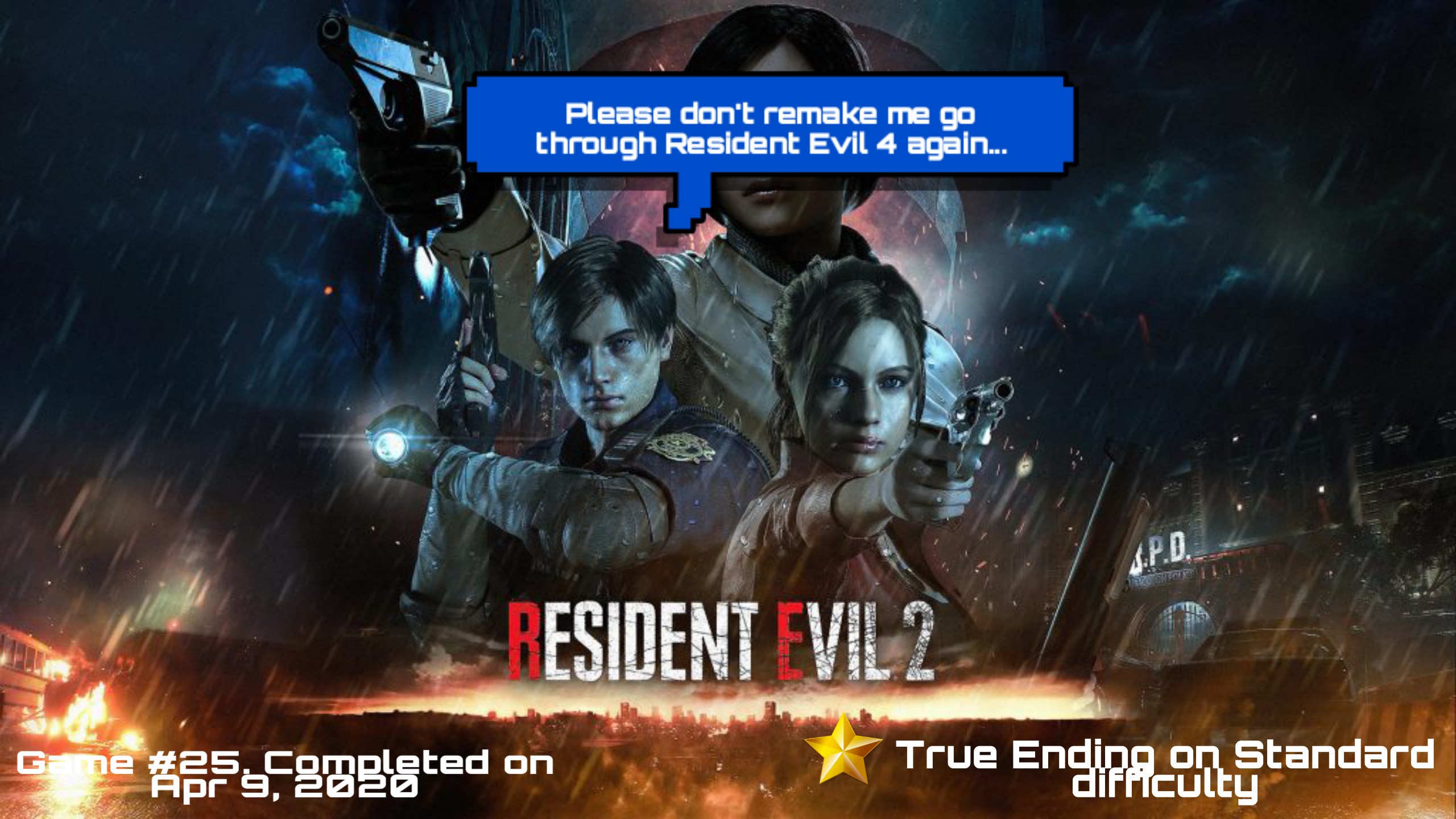
I finally saw the true ending in the Resident Evil 2 remake, but I first finished the “Leon A” route last year on the PS4. I played through the game again twice before the Resident Evil 3 remake came out (which I’ve also written about below). I wrote a lot about this game for my 2019 GOTY post (which you can read here) and my thoughts haven’t really changed since. It’s a phenomenal reinterpretation of a classic.
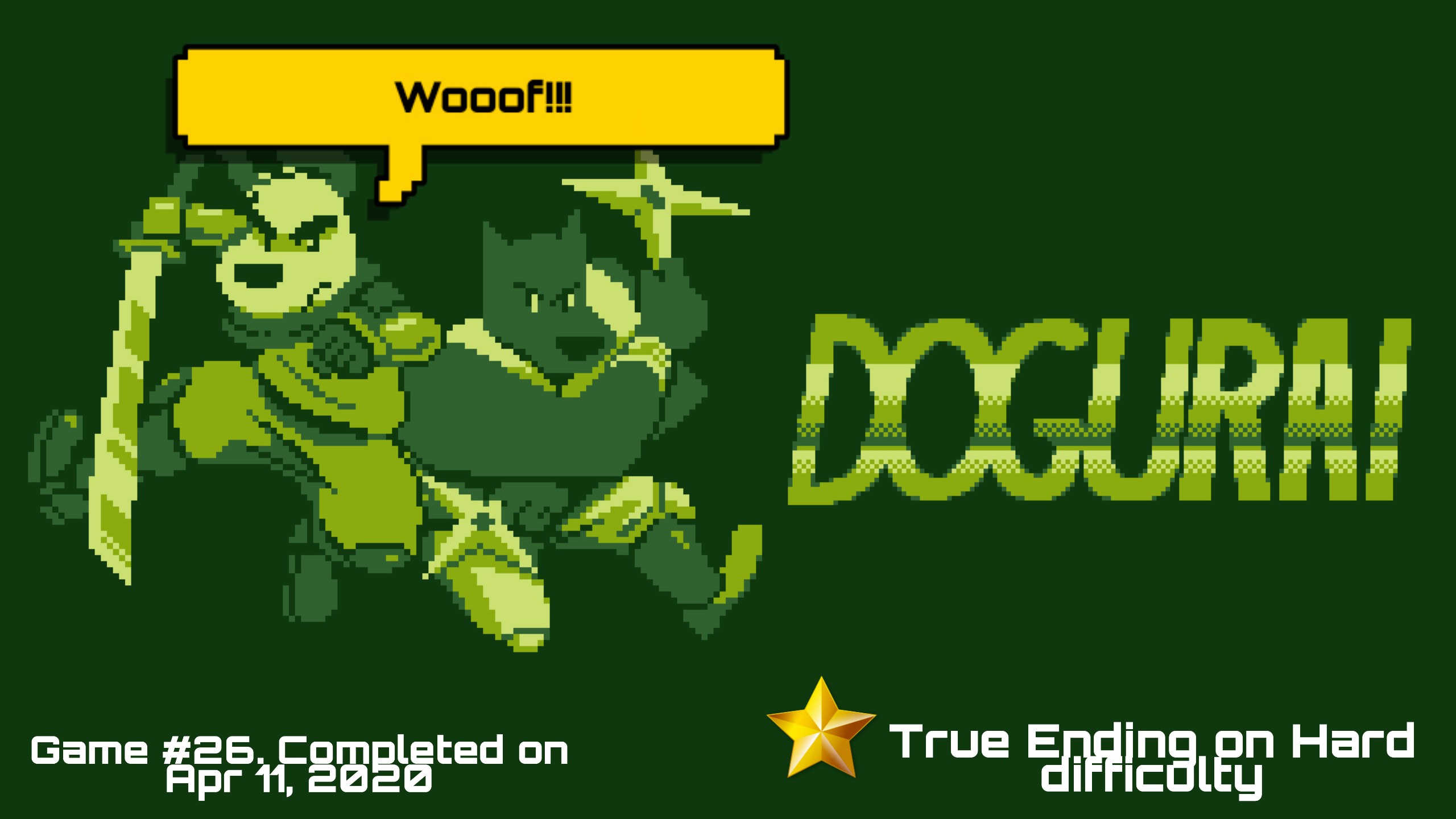
Dogurai, developed by Hungry Bear Games, is one of the more competent and enjoyable Mega Man-likes I’ve played lately. Like Squidlit, Save me Mr. Tako: Tasukete Tako-San and a handful of others that have come before it, Game Boy-inspired retro games with limited color ranges & simple sprites continue to surface on the indie scene. In Dogurai, you control a dog samurai named Bones and you’re on a journey to defeat a robot menace that has overtaken the world. The player can tackle stages in any particular order by choosing what are essentially “robot masters” from a map select screen. Stages are mostly short & sweet but still relatively challenging with a handful of secrets to discover and bosses to defeat, too.
While you don’t gain any new powers upon defeating bosses, it’s clearly evident that the Blue Bomber was a major influence here. Bones can double jump, destroy bullets with his sword and even perform critical attacks if you slash at an enemy/boss when it’s vulnerable. There’s even a Mega Man X2-styled bike sequence and a boss rush at the end of the game similar to what you would find at the end of a Wily Castle from any Mega Man game. I completed the game on the PS4 on Hard difficulty with the true ending and I would easily recommend it to anyone looking for an old school fix.
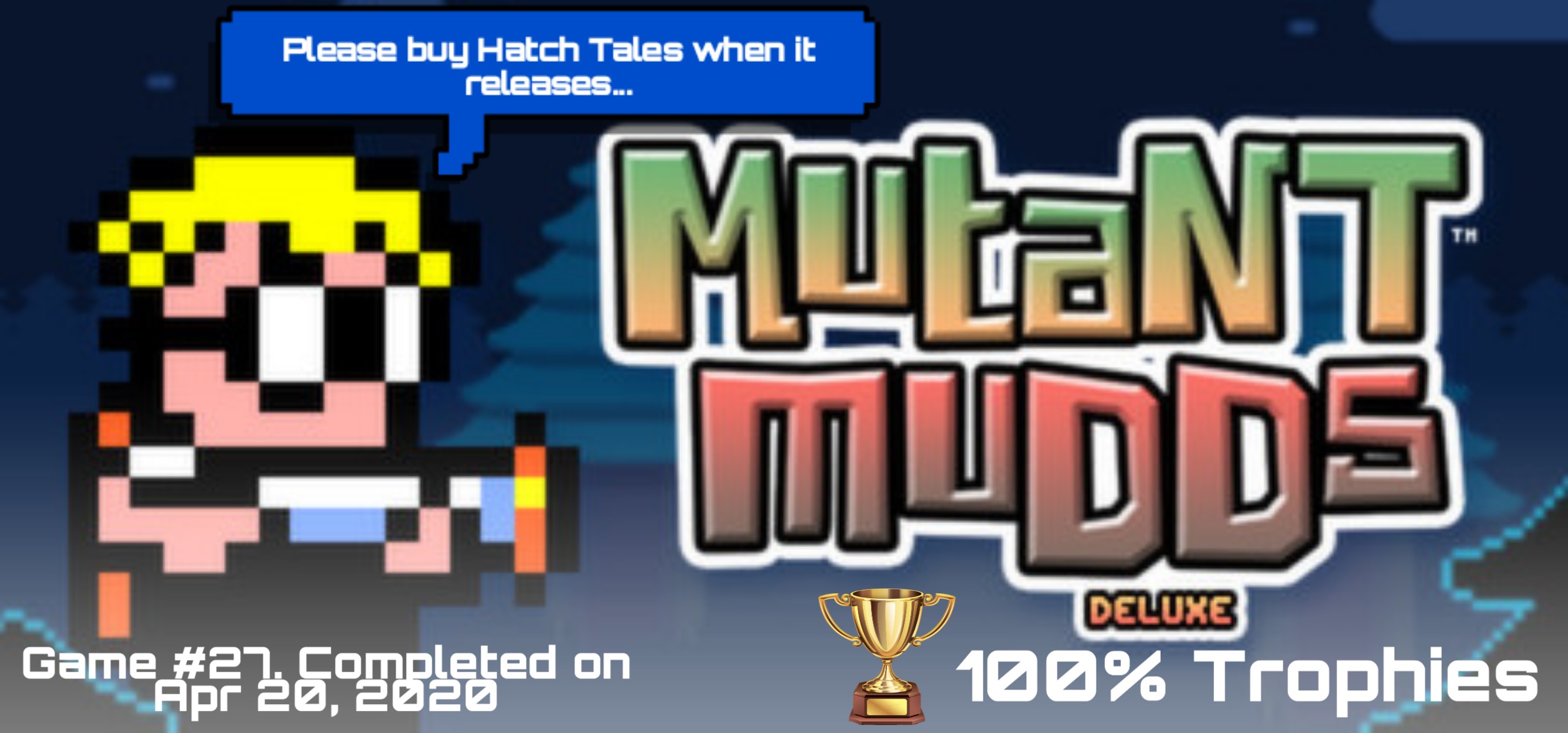
Atooi’s (formerly Renegade Kid’s) Mutant Mudds Deluxe is an enhanced port of the original Mutant Mudds with more stages, challenges and secrets to unlock. I’ve played multiple versions of Mutant Mudds and many other games by Jools Watsham over the years and while I almost always enjoy his offerings, they have always felt like they’ve been missing something that’s difficult to describe. Most of Jool’s games are lovingly-crafted 2D, retro-inspired platformers with beautiful sprite-work and some sort of gimmick/hook to set themselves apart from their peers. Mutant Mudds, for example, released on the Nintendo 3DS originally and took advantage of the 3D capabilities of the hardware by providing three different playing spaces you could essentially jump into and out of.
It was a cool visual technique for its time, but outside of features like this, there’s not a whole to chew after you’ve had your fill. Xeodrifter’s Metroid-like structure and inclusion of boss encounters (something that’s been missing from his previous games) made me appreciate his work even more, however. Chicken Wiggle (and the upcoming port/remake, Hatch Tales) is probably my favorite title from Watsham and the game I’m most looking forward to revisiting. I recently completed the deluxe version of the game on the PS4 with 100% of the trophies.
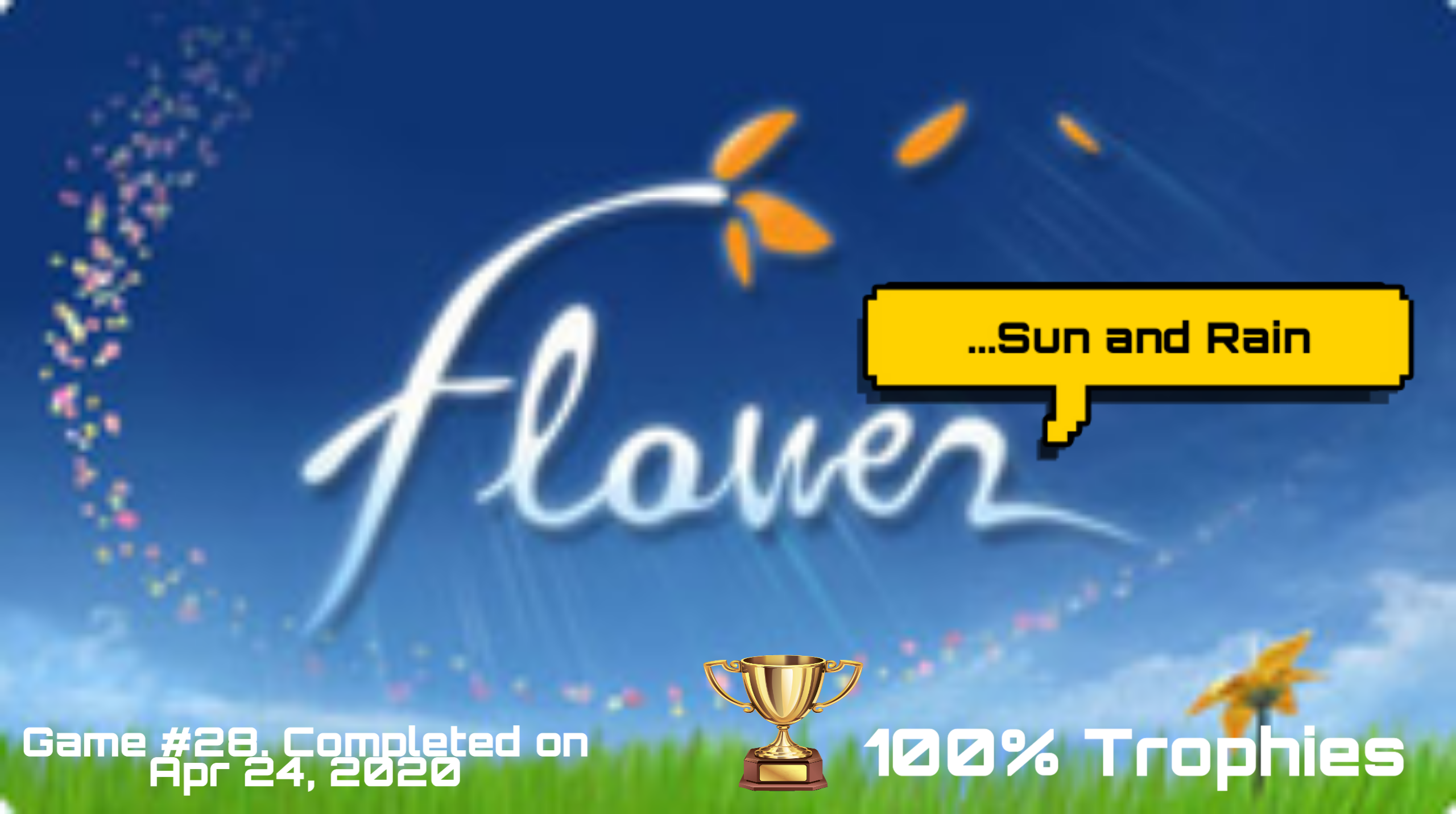
I completed Thatgamecompany’s Flower back on the PlayStation 3 (PS3), but I’ve needed a short, chill game or two to play during the pandemic. I decided to replay the PS4 port of Flower and it was a much needed moment of respite during these crazy times. This game has always been super relaxing to play as you simply guide a flower petal across fields and over hills while blooming other flowers and avoiding the occasional hazard along the way. There’s just something intoxicating/meditative about carving paths through blades of grass and letting your petal weave and bob as you idle and float in the wind. While the game isn’t exactly challenging, it’s never really been the point of the game. There are a few difficult trophies to unlock, however, so going for 100% completion can add some much needed replay value to an otherwise short-lived experience.

Biped, by NExT Studios, could quite possibly be my favorite indie puzzle-platformer of the year. There aren’t a lot of games that successfully use the Dual Analog control stick scheme today, if any. The way this game controls/plays reminded me of the time when I first played Ape Escape on the original PlayStation. Whether you’re playing single-player or cooperatively, moving the left and right analog stick forward will make your little robot buddy take a single step. It’s a control scheme that’s a bit difficult to describe, but it’s best to think of it as a “1, 2, 1, 2” motion on the left and right analog stick, respectively. If you hold both analog sticks down/forward at the same time, your robot will start to dash/glide around the playing space, giving you much more control and freedom over your movement.
Biped doesn’t have much of a story; it’s simply a collection of linear stages that can either be played solo or with a partner. You’ll solve simple yet satisfying environmental and physics-based puzzles while collecting coins along the way. Coins can also be traded for cosmetic items, but there’s nothing you haven’t seen here before in terms of unlocks/features. The real star of the show is playing the game cooperatively, however. Although you’ll play the same levels in both single-player and multiplayer, they are significantly different in their design and there’s also “Pro” levels specifically designed for multiplayer. Playing by yourself, for example, you’ll balance a seesaw in one stage with a surprisingly competent AI-controlled robot buddy, but in multiplayer, you’ll have to cooperate with your real-life partner to navigate the same puzzle. It’s imperative that you’re in-sync with your partner too or you’ll find yourself failing a challenge/sequence often (and you’re even given a rating it at the end of the stages depending on how well you and your partner performed).
Finally, I’d like to note one of the advertisements/trailers I saw online prior to the game’s release. The publisher/developers released a very Nintendo-esque commercial, complete with families and friends playing the game together on a couch, acting goofy and having a grand old time. Despite its somewhat generic robot/futuristic aesthetics, Biped feels like a game crafted with the same kind of care most first-party Nintendo games would have received, so I thought it was super interesting that the marketing for this game pivoted itself towards Nintendo’s more family-friendly appearance. Due to the pandemic, I haven’t been able to play this game locally, but I Share Played with a friend on PSN and it was an absolute blast. I don’t think I’ve laughed/smiled as much as I have over the past 6 months than I did while playing this game with a partner. I finished the solo levels on PS4 and completed a handful of the cooperative stages with a friend.
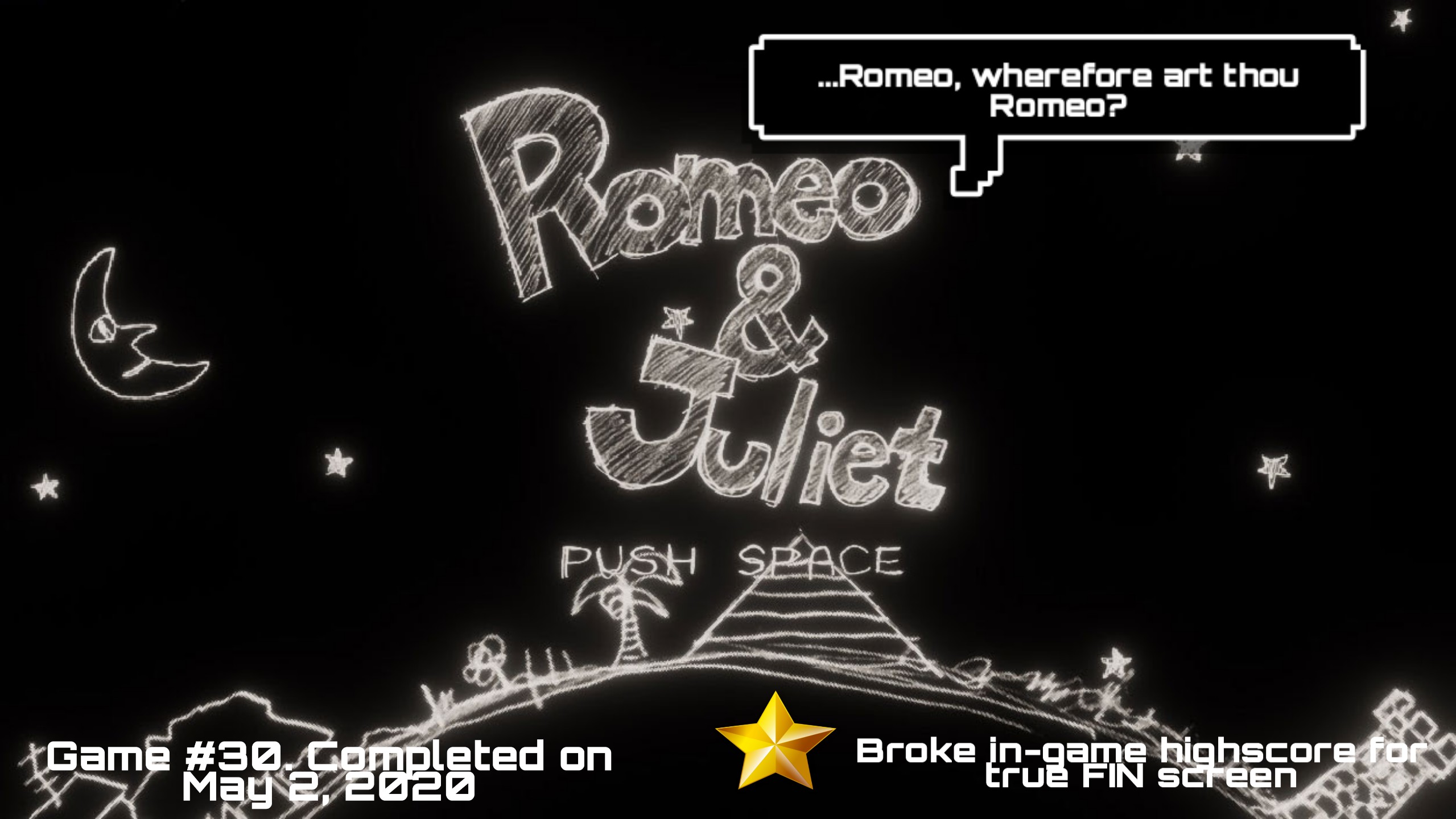
Onion Games, the developer behind titles like Million Onion Hotel (my personal favorite mobile game), Moon: Remix RPG Adventure (stylized as moon, which is finally getting localized), Black Bird and Dandy Dungeon: Legend of Brave Yamada, released a new “game”, ROMEO & JULIET for PC. By subscribing to their newsletter, you can download and play the game for free. ROMEO & JULIET is an incredibly simple game and the developers themselves describe the game as a “Mini Game”, at least according to their website. Aesthetically, it looks like someone drew the game with chalk, but it still carries that weird, quirky charm you’ve come to expect from Onion Games. It’s also a single-screen game; there’s no addition levels, screens or unlockables. ROMEO & JULIET is an arcade game in the purest sense and it heralds back to the era of Pac-Man and Donkey Kong.
In ROMEO & JULIET, your character is constantly spinning to the right and by pressing/holding the “left arrow” key, you’ll start twirling to the left. The 2D space that you’re on is extraordinarily small and your goal is to catch items falling from the sky while avoiding hazards that drop along with them. Mechanically, it’s also mostly similar to Onion Game’s Black Bird, at least in a score-chasing sense. There’s this constant feeling or risk/reward, which is extremely hard to capture in an arcade game. Do you risk your life for the larger items that give (presumably) more points or do you keep the combo multiplier going by grabbing what’s about to hit the floor? As soon as something hits the floor, your combo multiplier resets and once you reach Level 100, the game’s over.
It’s incredible satisfying to maintain your combo and because of the instant restart time, I found myself saying “just one more time” every time I failed. Unfortunately, there’s not a whole lot of replay value, but there is an ending if you reach a certain score threshold (another similarity to Black Bird). With that said, the game was free if you subscribed to their online news letter/website (which I highly recommend!). The folks over at Onion Games carry a particular legacy in the gaming industry that I simply adore and with moon finally releasing in the states at the end of August, there’s only more love to go around.
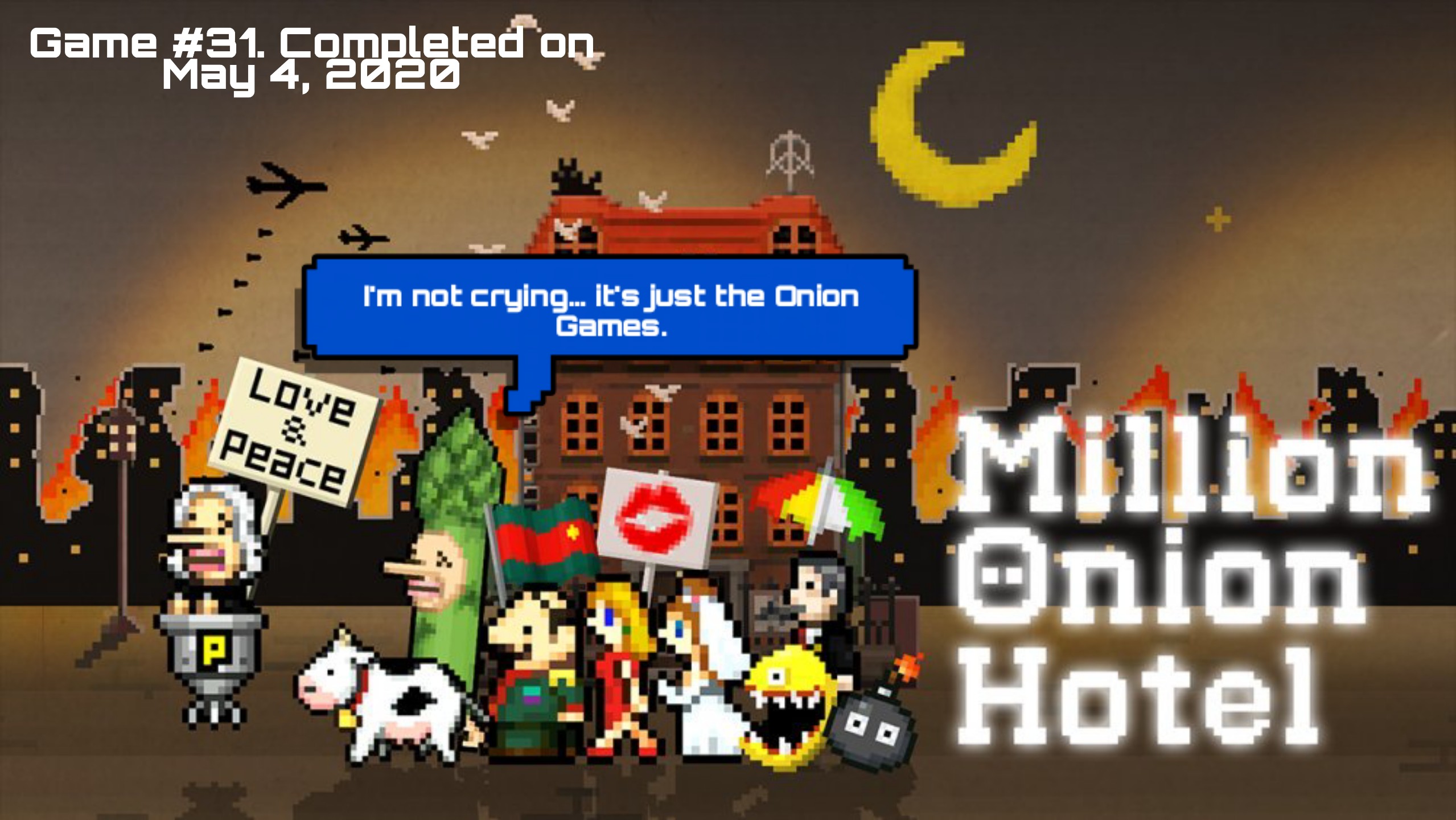
Million Onion Hotel, another title from Onion Games, is still my favorite mobile game of all time. I wrote a lot about this game last year (which you can read about here), but it truly is a unique, strange experience that you won’t find anywhere else. Unfortunately, I went to upgrade my phone a few months ago and my progress didn’t carry over (which is the reason why I don’t try to invest too much time/energy into mobile experiences). I love this game so much, however, I’ve already re-downloaded it to my new phone and I will likely start playing it again soon.
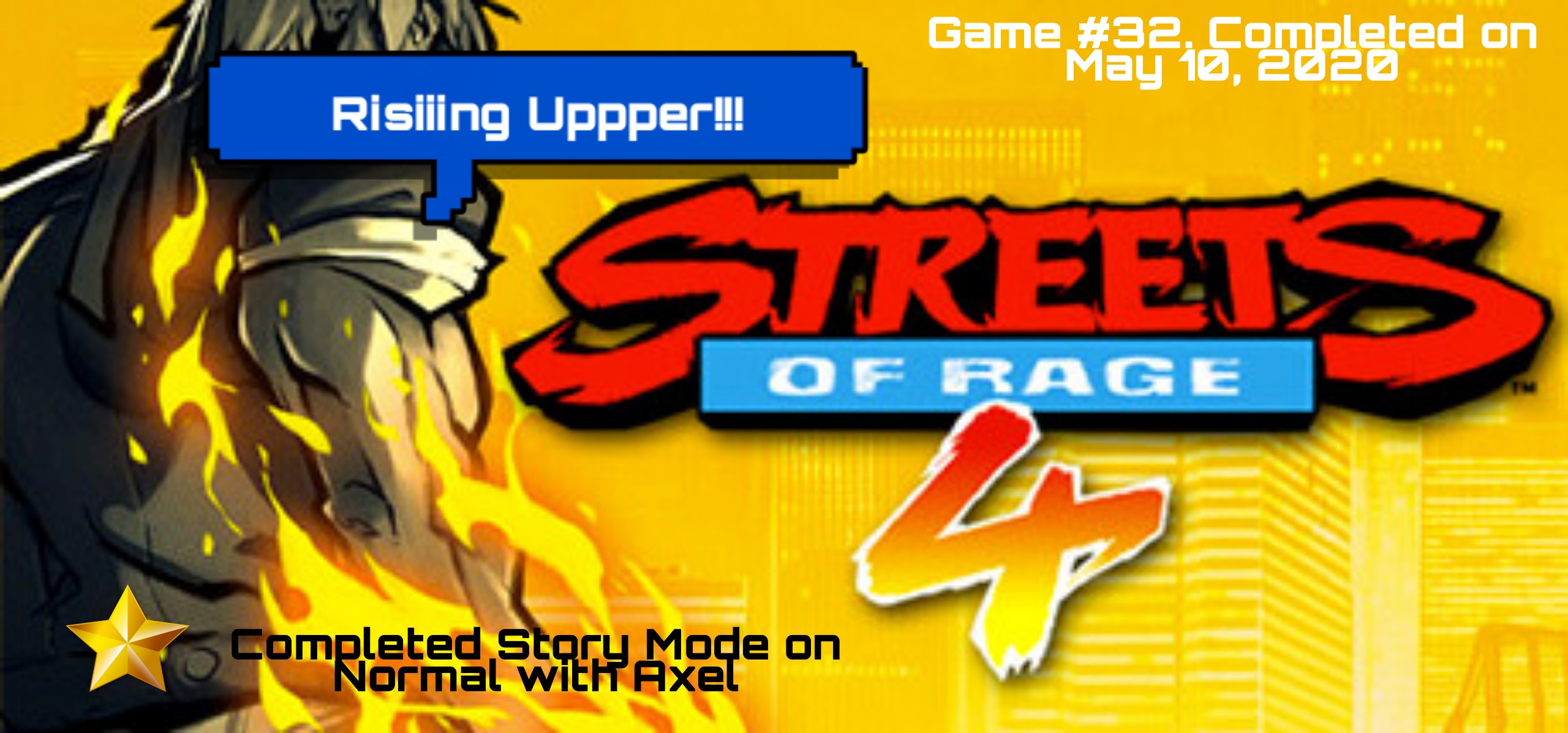
Streets of Rage 4 (SoR4), developed by Dotemu, Lizardcube, and Guard Crush Games, is the return to form many fans, including myself, have been wanting for. Sega has had sort of a redemption arc lately with the rousing success that was Sonic Mania, the rising popularity and localization of all things Yakuza and the release of Phantasy Star Online 2 (finally) in the west. So, what other dormant/forgotten Sega franchises/IPs have been overdue for a time in the spotlight? I grew up with the original SoR trilogy on the Sega Genesis and while there have been a few modern-day beat em ups over the past decade or so, there’s nothing quite like SoR in terms of classic brawlers and SoR4 nails it like a bat to Donovan’s head.
If I’m being brutally honest, I think a lot of the appeal of the original games were the soundtracks by Yuzo Koshiro. They’ve always been solid beat em ups, but they’re still relatively simple games, mechanically speaking, and they don’t really need to be anything beyond what the offer on a surface level. You’ll walk from left to right, beating up thugs and eating giant turkeys to restore health until you reach the boss at the end of a stage. While there’s sometimes the occasional hazard (like explosive barrels or pits), the level design has never been the main focus. The stage design in SoR4 doesn’t stray too far from the previous games, unfortunately, and I honestly wish it would have taken a few more risks. There’s new and old characters with distinct play-styles and abilities too, but nearly everyone can juggle/bounce enemies off of the screen (which is super satisfying by the way). It’s a relatively safe game, but a very good one at that so it’s hard to criticize and question “what could have been”.
If there’s one thing I was slightly disappointment in with SoR4, it was how they didn’t lean into its story setup more. Apparently, Mr. Y and his baddies are using music to brainwash folks on the street, but it just doesn’t come across as well as I would have liked it to. I was expecting to see enemies in cool idle animations by a boombox, listening to intoxicating beats before they pick a fight with you. Or maybe there could have been loud speakers visible throughout the city, blaring music and riling up thugs before they jump you on the pavement. Given the franchise’s soundtrack legacy and the inclusion of multiple composers this time around (Yuzo Koshiro, Olivier Deriviere, Motohiro Kawashima, for example), you would think there would have been more of a focus on implementing the music more into the atmosphere.
With that said, it’s still a genuine, honest follow-up to a franchise that has been sleeping for far too long. I completed the game on Xbox One (through Game Pass) on Normal with Axel and I look forward to jumping back in for additional runs when the mood strikes.
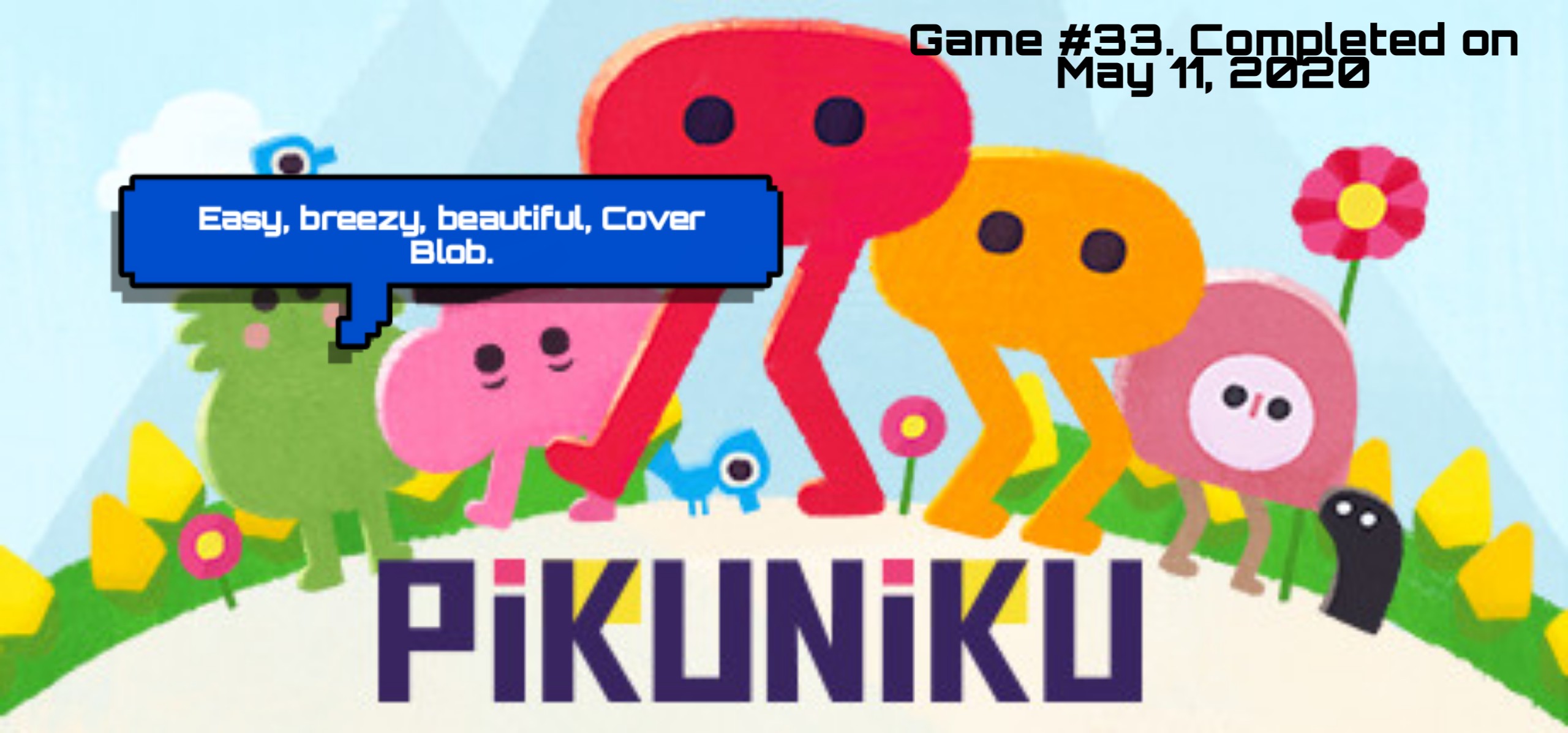
Next to A Short Hike and Paper Mario: The Origami King, Pikuniku was one of the most delightful experiences I’ve had all year. Developed by Sectordub, the game is essentially a 2D puzzle-platformer with a whole lot of Nintendo-like charm. In Pikuniku, you awake in a cave as a blob-like creature who’s considered a monster to those on the outside world. An evil entrepreneurial named Mr. Sunshine is harvesting the land’s natural resources for his own personal wealth, but in exchange for corn, trees and water, he gives the citizens of the land some coins, a basic universal income if you will. There’s definitely some real-world/political allegories on display here, but it ultimately doesn’t take itself too seriously. The game’s vibe lands somewhere between Paper Mario and Earthbound, I feel. The writing might come off as a little blunt/short to the player, but it’s well-written, funny and the characters, although very abstract and simple by design, are super charming in a Katamari Damacy sort-of-way.
Pikuniku’s controls are somewhat difficult to describe. There’s a degree of bounciness/unwieldiness in the creature’s movement, but you can walk and jump… I guess? Your character has stretchy legs and you’ll find yourself mostly fumbling through its numerous platform challenges. There are several town-like hubs with fun mini-games and secondary objectives along the way, too. The boss fights are weird, but creative and super satisfying to endure. The soundtrack, by Calum Bowen (of Lovely Planet fame), is also extremely catchy and appropriately themed. It’s simply put one of the warmest, most coziest games I’ve played in 2020. Despite releasing last year, it’s something I think everyone needs/should play given the state of the world (and you can check it out on Game Pass still). I completed the game on Xbox One and I cannot wait to see what these developers do next.
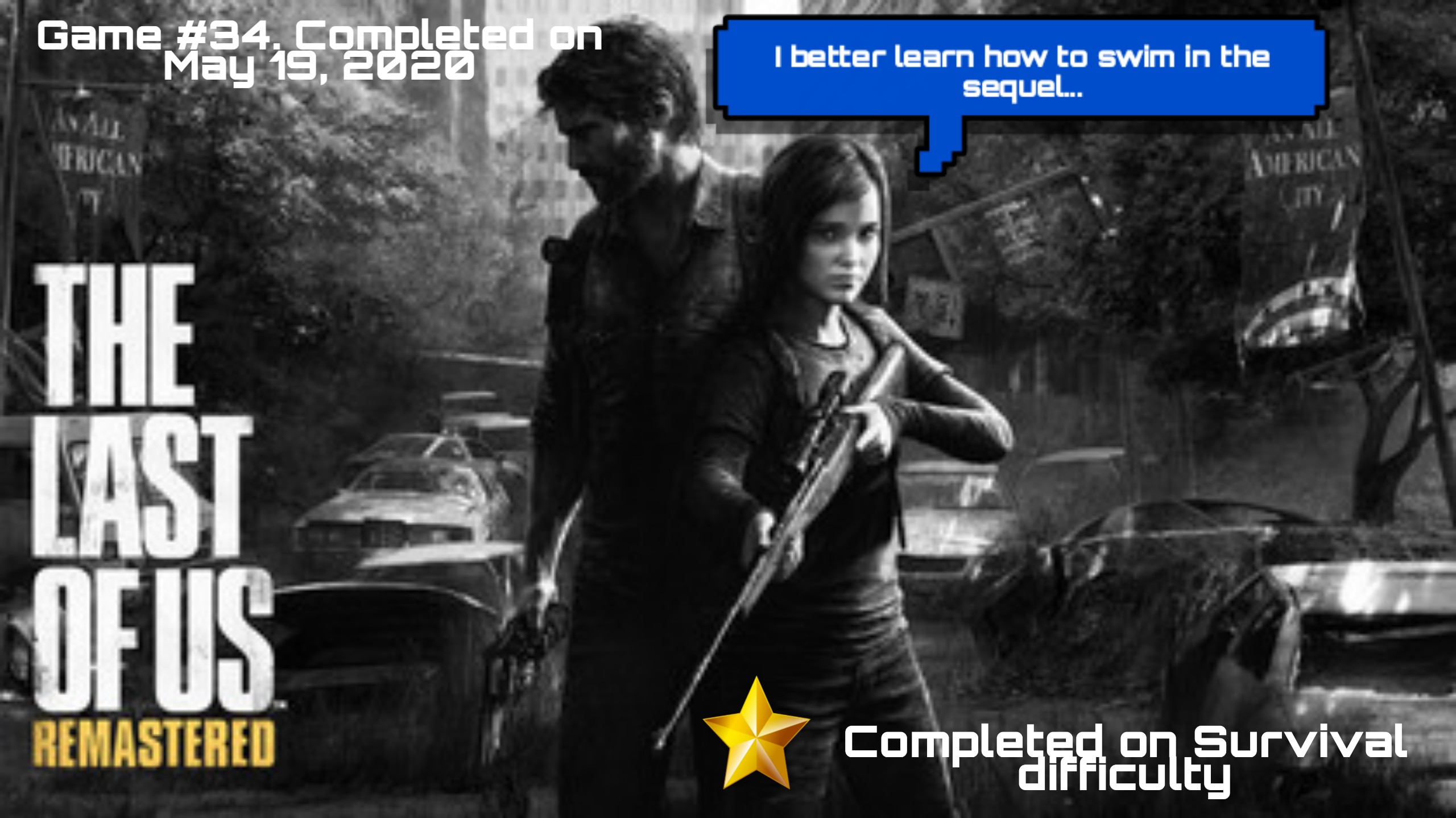
I’ve been playing Naughty Dog games since the original Crash Bandicoot on the PlayStation (PS1). For its time, they were competent, lighthearted 3D platformers developed for the PS1 in an attempt to pursue what every developer/publisher was trying to figure out; who/what was going to be the next big platform mascot? I enjoyed them for what they were back in the day and I developed a new appreciation for them when I replayed the games through the Crash Bandicoot N. Sane Trilogy on the PS4. Naturally, I found myself following the developer into the PlayStation 2 (PS2) era with Jak & Daxter: The Precursor Legacy (J&D). The first game in the franchise is still one of my all-time favorite 3D platformers.
It was clear that J&D was molded after Super Mario 64/Banjo-Kazooie. It was a seamless open world with virtually no loading times set to the backdrop of an objective-based, collectathon. Naughty Dog would ultimately chase the success/popularity of Grand Theft Auto (GTA) with their semi-open world sequels, which were much more dark, gritty and mature. On the PS3, the developer would graduate to Uncharted: Drake’s Fortune, a franchise I’ve always felt was more akin to Indiana Jones than anything else; fun, somewhat campy, globe-trotting, treasure hunting violence wrapped around a memorable, mostly likeable cast of characters. Finally, as The Walking Dead gained popularity, Naughty Dog released The Last of Us, a third-person survival horror soaked in human drama set in a post-apocalyptic world overrun by zombie-like creatures.
I love 3rd-person shooters; games like Resident Evil 4 and the original Gears of War paved the way for a lot of games today. With that said, I’ve had a bad habit of starting games on the highest difficulty available. I’d like to think (hope) that developers design harder difficulties around the idea that the game will ask more from me, at least in terms of understanding the mechanics and the combat options at my disposal. Some games/developers do this well (see Capcom and Platinum Games titles like most Devil May Cry games or Bayonetta on higher difficulty levels), but artificially making games harder by giving both the player/enemies less/more health, respectively, for example, is usually the path a lot of designers take.
I first tried playing The Last of Us back during its initial PS3 release, but I presumably got distracted by other games and dropped it (this happens a lot). When the PS4 version launched, I tried playing the game again on Grounded difficulty from the beginning… and let me tell you, it was a terrible idea! On Grounded, enemies are stronger, you’re much weaker, resources/ammunition is limited, and the HUD is gone, just to name a few things. If it couldn’t get any worse, Grounded also removes the ability to track enemies by sound, so the (R1) button used to sense enemies through walls is no longer a viable option. It’s clearly not meant to be your first play-through, unless you’re a masochist. I learned my lesson the hard way and after 7 years since its initial release, I finally finished The Last of Us: Remastered… on Survivor difficulty.
The Last of Us is still a gorgeous looking game. The art direction is fantastic and the attention to detail is second to none. The empty rooms, buildings and notes you come across tell stories of those who were less fortunate. The audio/visual design is clearly some of the best in the business, too. The sound of the clickers, one of the game’s infected enemy types, is horrifyingly distinct. While it’s also a solid, somewhat safe 3rd-person shooter with stealth elements, weapon crafting and a rudimentary upgrade system, the game just feels good to play. Your character’s movement has a certain weight/momentum to it and the impact of your weapons, whether you’re applying a piece of plywood to an infected creature’s face or aiming your shotgun at a Bloater’s weak-point, feels crunchy and satisfying.
More so than anything else, however, The Last of Us is about the characterization and human drama between a group of survivors stacked up against the worst possible odds. The infected creatures and post-apocalyptic setting is only second to the complicated relationship between Joel and Ellie. Most individuals, if not all people who cross their paths are met with disaster and devastation and the two meet a lot of interesting characters along the way. It’s a powerfully depressing game that still holds up, even in 2020. There’s not a whole lot to say that hasn’t already been said about The Last of Us, but it’s not without its problems. For a game that feels as grounded, realistic and immersive as it is, your AI partners sure go out of their way to break any sort of immersion.
While it’s been debated since launch, your allies are invisible to the enemies. Because of this, they’ll find themselves running around or crouching into and out of cover when an enemy is clearly within their sight. If the enemies could spot your partners, it would have likely created a more frustrating experience for the player, so I understand the design decision behind this. It’s not game-breaking by any sense of the imagination, but it certainly breaks some of the tension during a combat encounter. Speaking of combat encounters, while the game is certainly challenging on the higher difficulty modes, there are a handful of forced encounters that you can’t stealth-by/skip. With that said, the game is generous with ammo drops from enemies if you’re running low, so I’d like to think you’re never locked out of making progress if you’re more liberal with your resources.
I also appreciate how the game subverts your expectations at various points throughout the journey. There was one instance, particularly late in the game, that really stood out to me where Joel goes to prompt Ellie for a boost up to a ledge. It’s something you’ve done countless times, but in this instance, Ellie doesn’t automatically come over. Instead, she’s found sitting, distracted and absent-minded on a nearby bench. Over the years, I’ve seen criticisms launched at the game for having too many ladder-climbing/box-pushing sequences, which is a fair critique, but the game at least does a decent job at playing around with the idea and the pacing, overall, is top-notch.
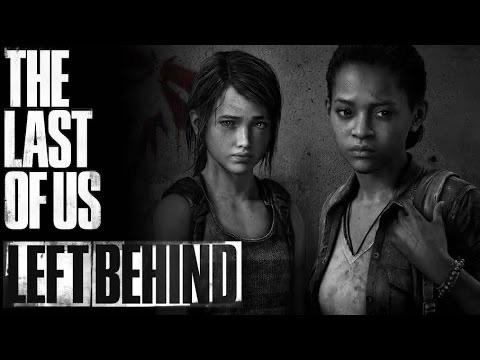
Finally, right before the launch of The Last of Us: Part II, I played through Left Behind, the DLC that was released for the original game (but included in the Remastered version) which focuses on Ellie and her best friend, Riley, before (and during) the events of the original game. It’s a supremely well done piece of content, a slice of life if you will that paints a better picture of who Ellie was before the events of the first game. Most of the DLC has you exploring an abandoned mall while learning more about the relationship between Ellie and her best friend. The other half of the DLC plays out during the middle of the original game when Joel is injured and Ellie is looking for supplies during the winter.
Left Behind still plays similar to the original game, but this time, infected and human enemies can interact with each other, which wasn’t really an element of the first game. There’s a ton of great moments/sequences here too; making goofy faces in a photo booth, pretending to play a busted arcade machine or having a water gun fight. It provides a somewhat lighthearted escape for not only the two characters in the game, but also the player who’s seen just as many horrors as they have. Of course, none of this lasts forever and the two find themselves pursued by the infected before the short episode is wrapped-up and left ambiguous for your interpretation.
2020 has been a hell of a year and playing something like The Last of Us wasn’t exactly a pleasant experience. With that said, I’m glad I finally saw both the original game and its DLC through to its conclusion. It’s still a great 3rd-person, survival horror with an interesting story and an engaging cast. As of writing this, I’m also still in the middle of The Last of Us: Part II (which I have a lot to say about and will save for a future post).
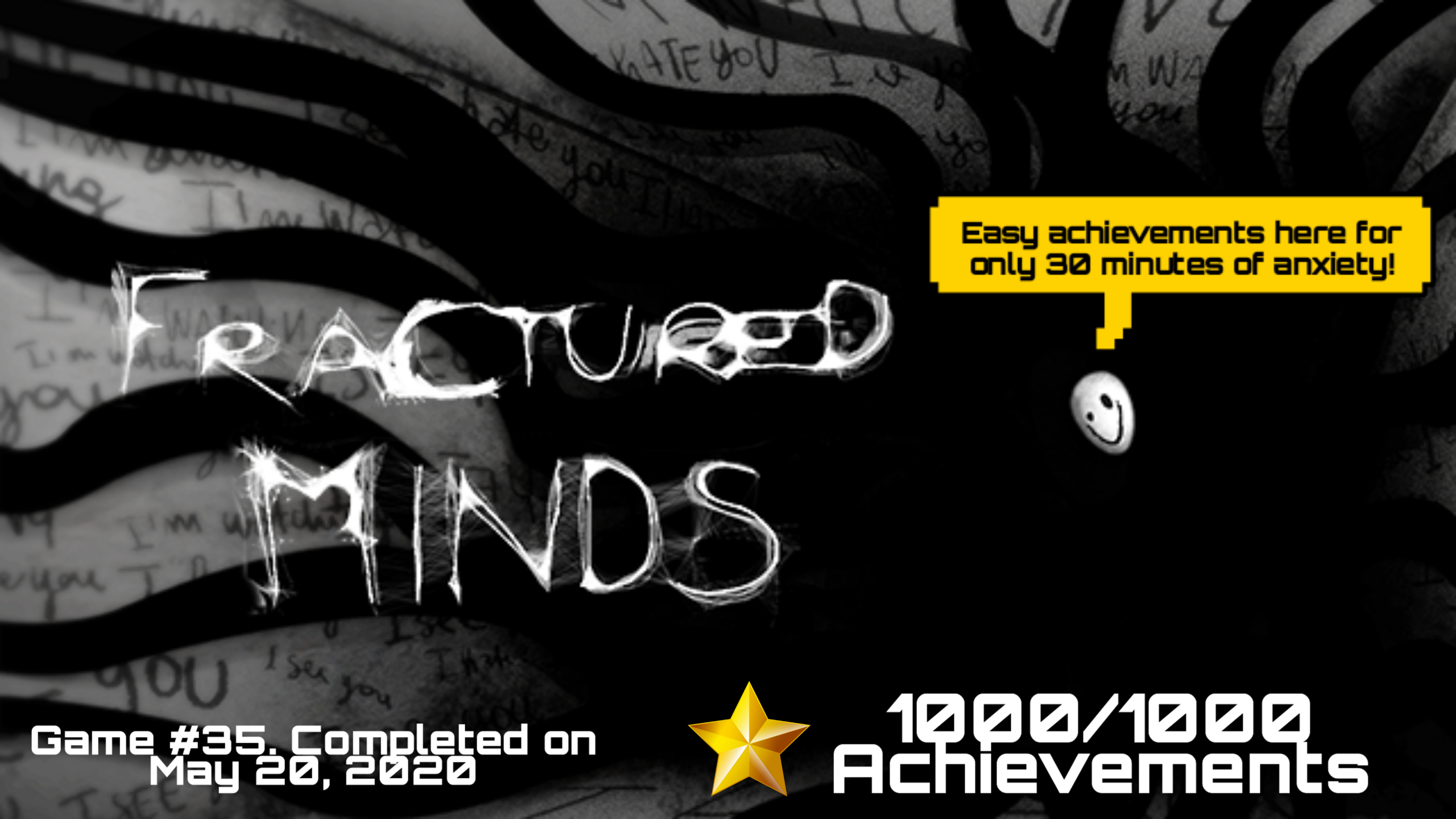
Mental illnesses are serious and they suck. As someone who’s been on medication for anxiety/depression in the past, simply waking up and getting out of bed can be a herculean effort. Fractured Minds is yet another game that tackles such issues, but similar to how I felt about last year’s Sea of Solitude, sometimes games that try to bring awareness to psychological disorders can be difficult to relate to. The game itself is a simple first-person, puzzle-solving experience split between a handful of chapters that collectively won’t take you longer than an hour or two to complete. The first stage, for example, has you trying to leave a room that’s been locked. There are keys scattered about the environment and whenever you collect one and attempt to exit the room, it always ends up being the wrong key.
Naturally, if you felt like you were trapped in a space and you couldn’t escape, depending on the person, one could begin to panic (and I’ve been there plenty of times in public), so the game plays on real-life situations in relatively safe environments (such as a bedroom in this case). With that said, the game was also designed by a 17-year old named Emily Mitchell and she also won the BAFTA Young Game Designers Award, so that’s very cool. I’m not sure how I feel about collectables/achievements in games about serious mental conditions, but I’m still a completionist at heart, so I finished the game in one sitting with all of the achievements unlocked on Xbox One through Game Pass.
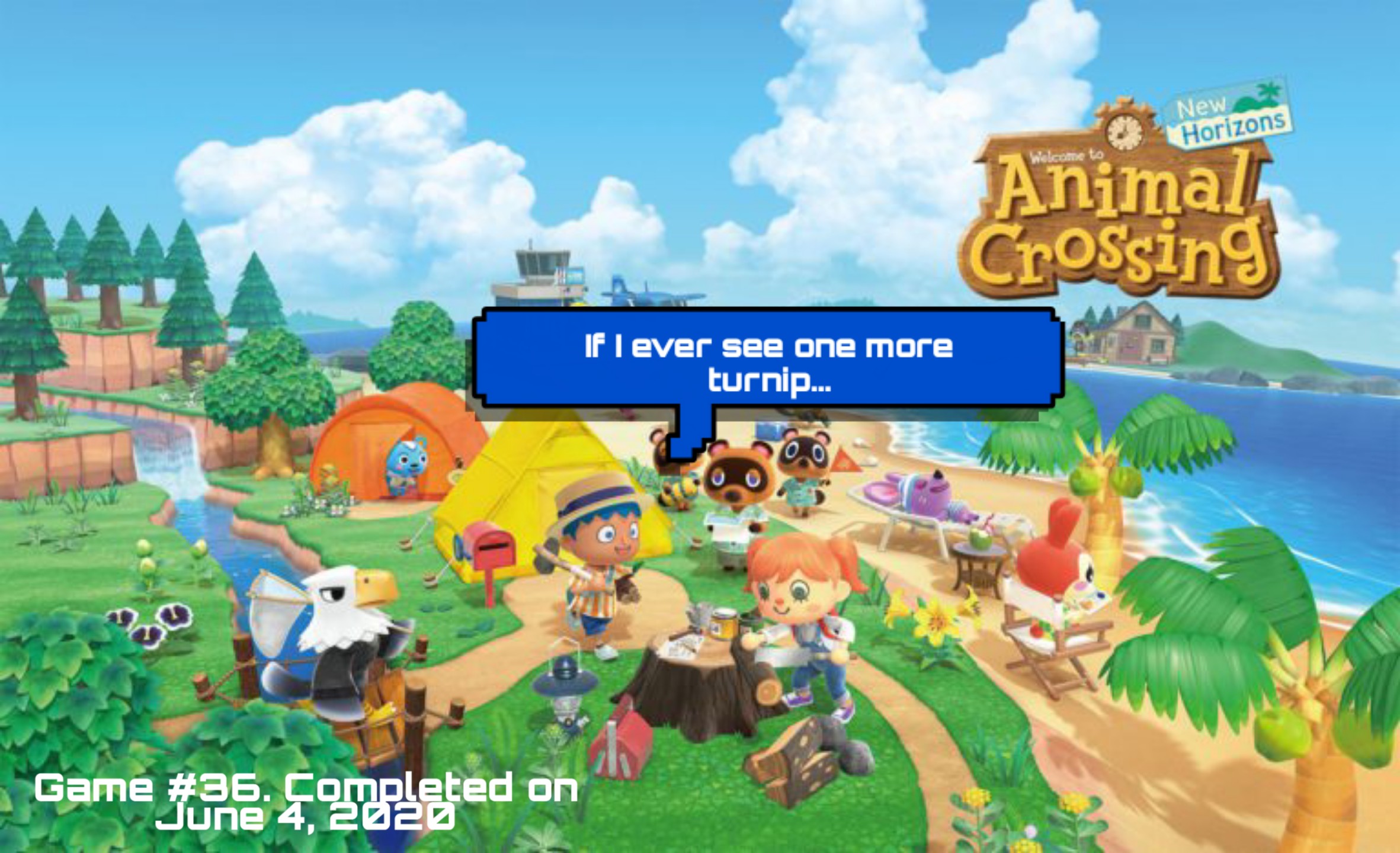
Animal Crossing: New Horizons has been quite the success story. It’s one of the best selling games for the Nintendo Switch and it hasn’t even been out for a full year yet. The game launched during the initial height of a global pandemic, so while most people were stuck at home, dealing with existential dread, anxiety and stress, why not live your life vicariously through overly positive animal friends? Plus, you can decorate a home on a tropical island, a travel destination that still feels like a distant dream, even today, 6 months after its release. That’s if you could actually find the system, if you didn’t already own one. Needless to say, Nintendo walked into the perfect storm.
I grew up with and still love Nintendo, but for whatever reason, there are a handful of franchises I’ve yet to spend any significant time with, Animal Crossing being one of them. I’ve surprisingly purchased most of the games in the past, dating all the way back to the original GameCube release, but I’ve only dipped my toes into an entry or two before dropping them. I’ve never been too hot on games like Sim City, Harvest Moon or even the Sims; games where there’s seemingly no end in sight and the onus is placed on you, at least in terms of creating your own fun or setting your own goals. My understanding of Animal Crossing prior to playing New Horizons was that it was similar to those aforementioned titles, only with Nintendo’s usual polish/charm. Boy, did I underestimate how much time I would have spent with this game so far.
In the beginning, I was most interested in the game’s structure. As someone who enjoys studying game design, I was most interested in how features, unlocks and mechanics were doled out over the course of the game. For Animal Crossing, I’ve always been on the outside looking in, so I didn’t have much of a reference point. At the beginning, you can create your character and choose your island from a random selection of topography. From there, the game slowly eases you into many layered systems that aren’t immediately apparent/explained to the player. You’re also assigned a random fruit at the beginning, which can be grown and then sold on other player’s island for more bells (the game’s currency), which is to encourage you to partake in the multiplayer components (more on that later).
At its core, Animal Crossing is a day-to-day life simulator, complete with day and night cycles, annual events and other festivities. On most days, you’ll find yourself harvesting materials, helping villagers with menial tasks, catching bugs/fish for your museum collection or crafting items to make your house/island more beautiful, but there’s much more here if you’re willing to invest the time. Visiting other player’s islands or having them come see you is an integral part of the game. Some seasonal items are exclusive to other player’s shops and other activities (such as bug/fish tournaments) can be completed more efficiently with friends. I’ve been fortunate enough to have a group of long-distant friends who are more versed with Animal Crossing, so my experience playing with others has certainly been fruitful.
One (dangerous) hole I found myself digging into was the Stalk Market; buying turnips at a low price and then selling them high. Every Sunday, a sweet, old lady can be found on your shorelines selling turnips for a random price. What’s interesting, however, is that the price could potentially be lower on other player’s islands, so you’re incentivized to “ask around”, so to speak, to find the cheapest price. From Monday through Saturday, you have an opportunity to sell these turnips at your shop, but the amount you can sell them for fluctuates. To make things more complicated, your turnips will rot if you don’t sell them by the following Sunday. It’s a simple risk/reward system that adds a degree of pressure/anxiety during your week, if you decide to partake in such an investment.
Once you craft all of your necessary tools, gain access to every area on your island and pay off all of your home extensions, it’s easy to find yourself lost to the daily grind. While there are Nook Miles to complete (the in-game achievement system), a lot of them require you to play the game extensively and perform tasks like catching/crafting “X” amount of fish/bugs and items, respectively, among other things for weeks on end. So, unless you have some grand image for your island, the game’s really about making your own fun/setting your own goals. After 100 or so hours, I found myself at a crossroad in terms of decorating/customizing my island. It’s easy to just throw anything down with no rhyme/reason, but your island can become quite chaotic and messy, so where’s the satisfaction in that?
I hardly ever role-play when I play sim-like games or MMOs, but here we are. I named my island Phantomile, which is the name of the imaginary kingdom from a PS1 era platformer called, Klonoa: Door to Phantomile. It’s one of my all-time favorite games, but it’s been dormant for quite some time now, so why not pay tribute to the game since Namco Bandai has no intention on bringing the franchise back (I’m not bitter, I swear). In Klonoa, you’re a dream traveler who falls asleep and drifts to a dream world in peril. On my island, I’m acting as if my villagers are dreaming about their previous lives and their dreams (which I write on the town’s sign board) are then reflected on the island visually/aesthetically. I plan on writing a dedicated post about this idea, specifically, in a future post.
I’ve logged nearly 250 hours since April and I don’t see myself stopping anytime soon. Although I’ve seen the “credits” (K.K. Slider has visited my island), there’s really no end to Animal Crossing. I’ve gone on island tours, participated in meteorite shower gatherings and fishing tournaments with long-distance friends, earned millions of Bells through the turnip exchange and purchased all of my home expansions. One of these days I’ll have a 5-Star Island, too! But in the meantime, it’s been my “morning coffee” game when I log into work from home. I’m looking forward to sinking another 250 hours well into the new year.
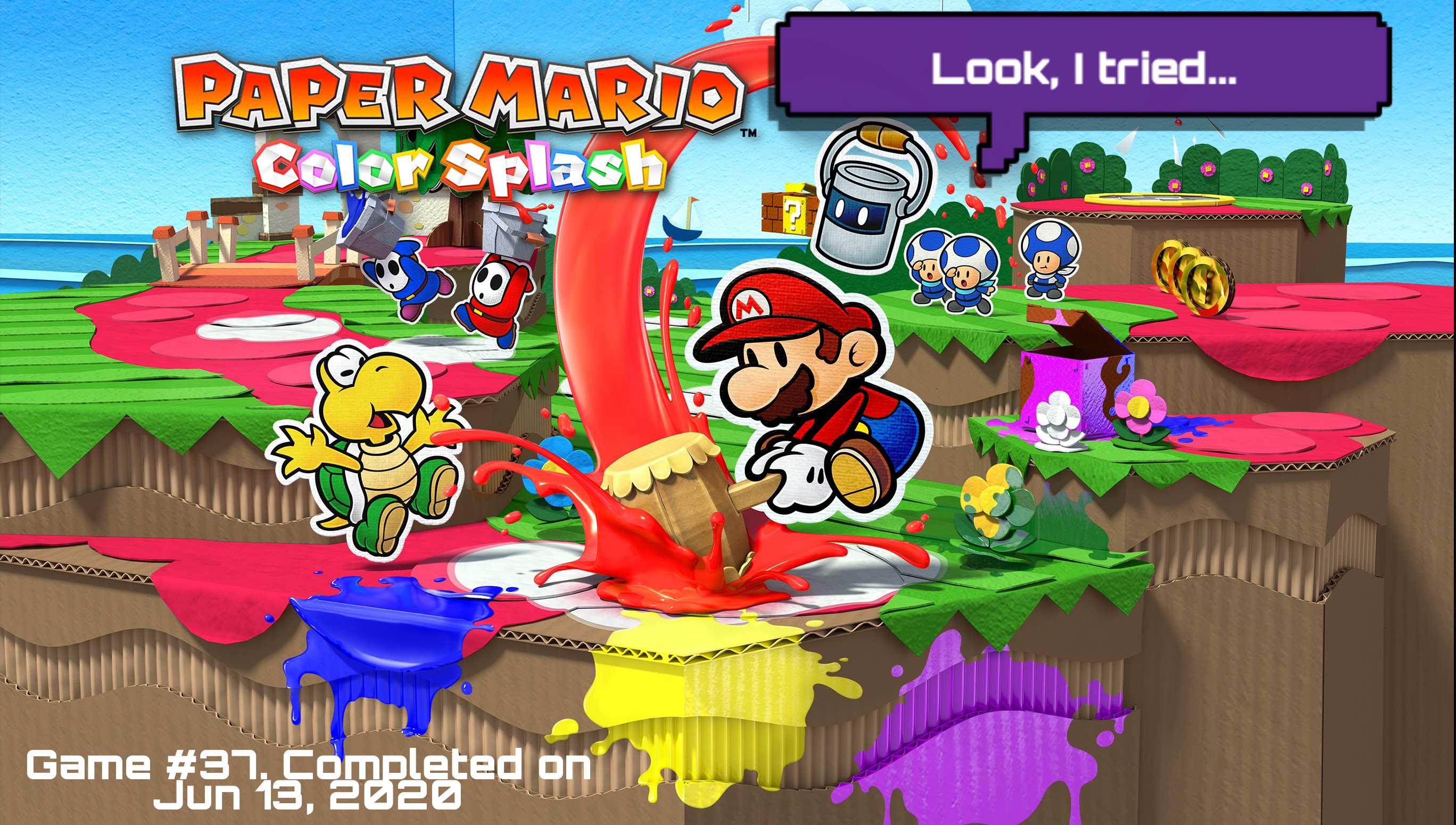
I really liked Paper Mario: Color Splash. Although Sticker Star has been deemed the beginning of the downfall for the franchise, Color Splash was clearly an attempt to build upon the ideas crafted for the 3DS entry while simultaneously making attempts to correct this mistakes that were made along the way. While there’s no partners, traditional experience-point system or character progression through the usage of badges, Color Splash, yet again, embraces what it means to be disposable. All combat options are tied to cards that you collect, but they’re essentially consumables. The default options have you flicking the cards with your stylus on the Game Pad (which isn’t exactly fun), but you can change it so everything can be controlled with the analog stick and buttons instead.
“Things” are back as well, which act as real-world items that are used mostly for solving environmental puzzles, but they’re also necessary to defeat bosses. These “Things” range from a giant oscillating fan to salt & pepper shakers. In a beach level, for example, the giant oscillating fan is used to create a massive wave in the ocean so a toad can get back to its shore. It’s ridiculous, yet creative and arguably out-of-place, but I also can’t not think about how Chibi-Robo’s and Pikmin’s real-world items (like Tootsie Pops and Duracell batteries, respectively) have somehow had an influence on Paper Mario post-Sticker Star. Some people hate it, but I actually love and welcome the addition of these real-world items.
Color Splash also has a relatively simple story, but it’s not without its clever writing and sense of humor, two aspects of the franchise that are seemingly a requirement at this point. Something has clearly gone amiss on a nearby island and Mario & Princess Peach set sail to discover what’s troubling the inhabitants of Prism Island (which also happens to be shaped like a paint brush). Upon arriving to this island, the inhabitants of Mushroom Kingdom realize that all of their magical paint has been stolen (presumably by Bowser) and Princess Peach (once again) gets kidnapped. You’ll encounter an empty paint can, named Huey (who’s obviously extremely witty) and you’ll set-off on a journey to find giant paint stars in order to return the island back to its former glory. It’s a fun, cute story that has its moment or two, but it’s nothing to write home about.
Paper Mario games post-Sticker Star have been criticized for both their lack of original NPCs and their over usage of vanilla characters from the already well-worn/established Mario universe and while it’s certainly a fair criticism, the writing certainly makes up for it. Paper Mario: Color Splash is an extremely well-written game and it’s actually really funny, most of the time. In a recent interview, one of the producers has claimed that the development team is no longer capable of “modifying” Mario characters. While this is certainly disappointing (since we’ll never see a cast as strange and diverse as the characters found in the original N64 game/The Thousand Year Door), the writers/localization teams should be praised for their ability to make generic-looking toads, for example, feel unique and distinct from each other. It’s the finest example of working within limitations and doing your best with what’s given, so I applaud their efforts.
Finally, if your enjoyment of Paper Mario hinges on the fact that there’s no experience points after battle, then you’re probably never going to like anything beyond Sticker Star and I personally feel like it’s a misguided hangup. While I understand things like badges and partners added some much needed depth/customization to an already relatively simple turn-based combat system, those aren’t the only factors that define Paper Mario. Even with some questionable design decisions and lack of traditional character progression, if you’re simply a fan of Mario/adventure games with light-RPG elements, Color Splash is a lovingly-crafted adventure that’s well worth your time.
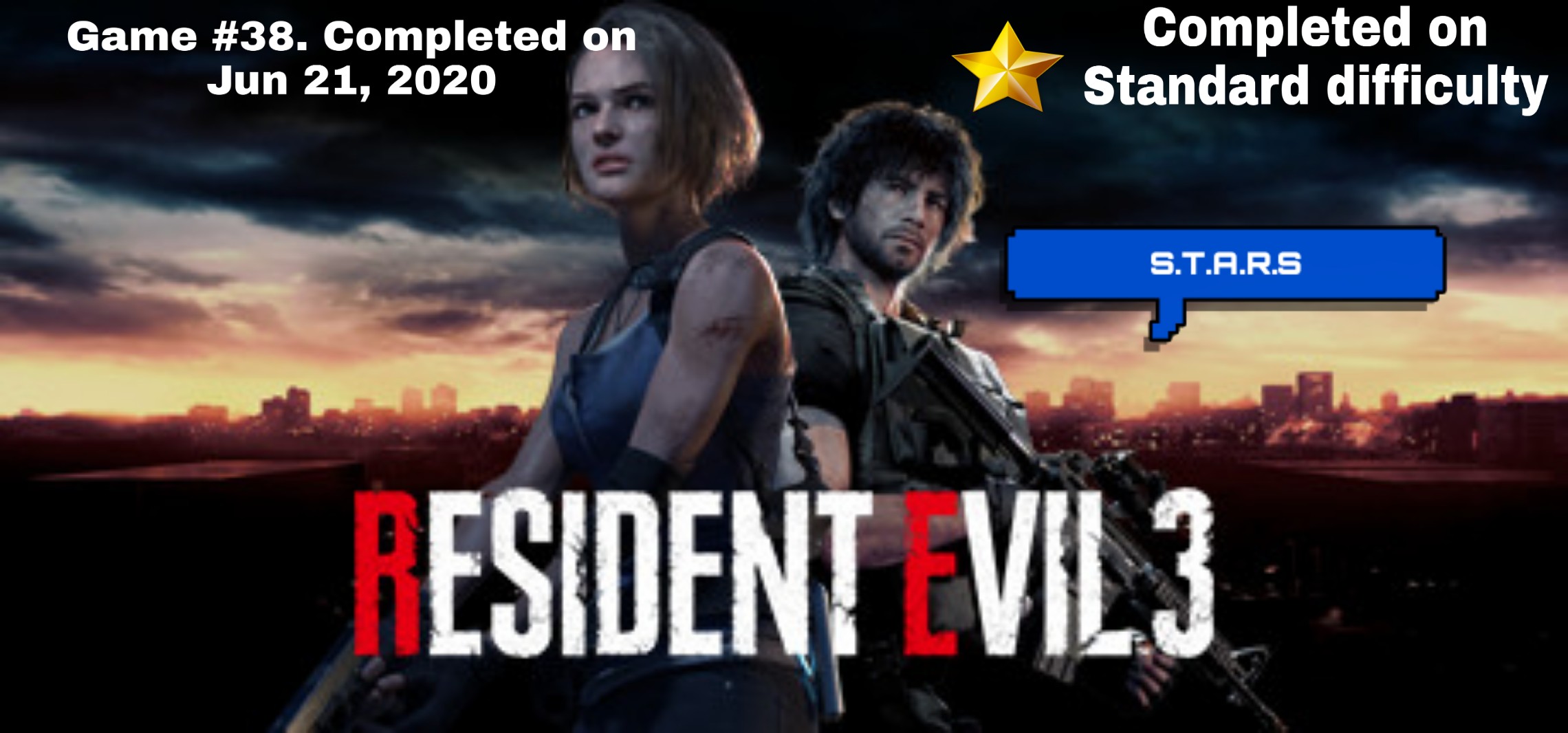
While Capcom’s Resident Evil 3 (RE3) remake may not be as impressive as the Resident Evil 2 (RE2) remake that came before it, it’s still a competently made companion piece, similar to how the original release was perceived back in 199X. There’s something missing from the RE3 remake that’s hard to describe, however. Outside of some major areas from the PS1 game that are conveniently missing (the clock tower, for example), it feels as if it’s almost a bit too refined/streamlined. It’s way more action-oriented than RE2, but so was the PS1 version, which isn’t necessarily a bad thing. The flow of the game is much more linear and there’s an abundance of ammunition and high-powered guns at your disposal, too. There’s also a dodge mechanic that’s certainly welcome, which happens to feel more realized and useful than it was in the original game.
I really liked the new character models for all of the returning characters and I enjoyed listening to the voice actors/actresses that were chosen to play their roles, too. I think this game has my favorite characterization of Jill Valentine, too. She’s always been a confident, no-nonsense woman, but there’s just something about her in this remake that elevates her even higher. Finally, one of the more interesting aspects about the RE3 remake was how the game started in first-person view. After Resident Evil VII’s first-person direction (which was new for a mainline entry at the time), many questioned if all RE games were going to be first-person going forward, considering the former game’s success. Capcom is clearly not done with their first-person experimentation either as the upcoming Resident Evil VIII is going to be, once again, in first-person view.
In retrospect, now that I’ve played the majority of The Last of Us: Part II, it’s interesting looking back on my time spent with the RE3 remake, considering they’re two 3rd-person survival horror games released in 2020. I think they’re both on opposite ends of the spectrum, at least in terms of one being perhaps a bit too lean while the other feels too lengthy and somewhat bloated. I think Capcom and Naughty Dog could learn a thing or two from each other, but as someone who’s a bigger RE fan than The Last of Us, I sort of wish both RE2 & RE3 received the same treatment/budget that Naughty Dog can clearly flex. I completed the game on Normal difficulty, but due to its short length, the game’s highly replayable and there’s a plethora of unlocks to pursue and difficulties to challenge down the road.
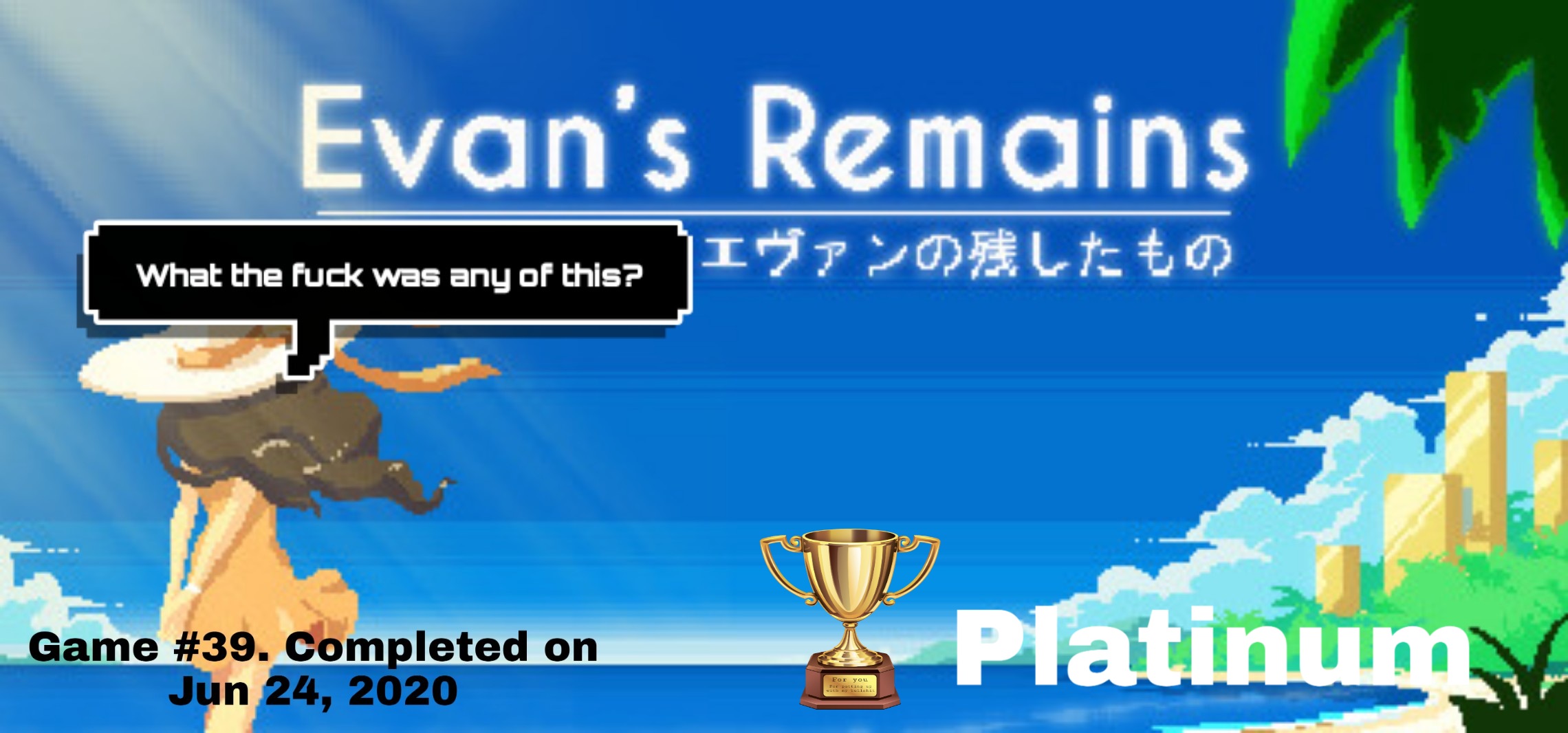
Evan’s Remains, by Matias Schmied, is a peculiar title. You play as a girl looking for a boy name Evan and you’re better off not knowing anything else about the story beyond the initial setup. At its core, it’s mostly a visual novel with logic-based, puzzle-platforming sequences thrown in-between the story beats. While the puzzles are nothing you haven’t seen before, they slowly become more challenging and build off of previous ideas. With that said, you actually don’t even have to play the puzzle portions of the game. You can essentially skip every puzzle “room” and finish the game by simply reading through the dialogue. It’s a bold choice, but it allows for players to customize their play-through and skip a sequence if they’re struggling. I completed the game with the Platinum trophy and the story was definitely one that stuck with me for a few days. Highly recommended.
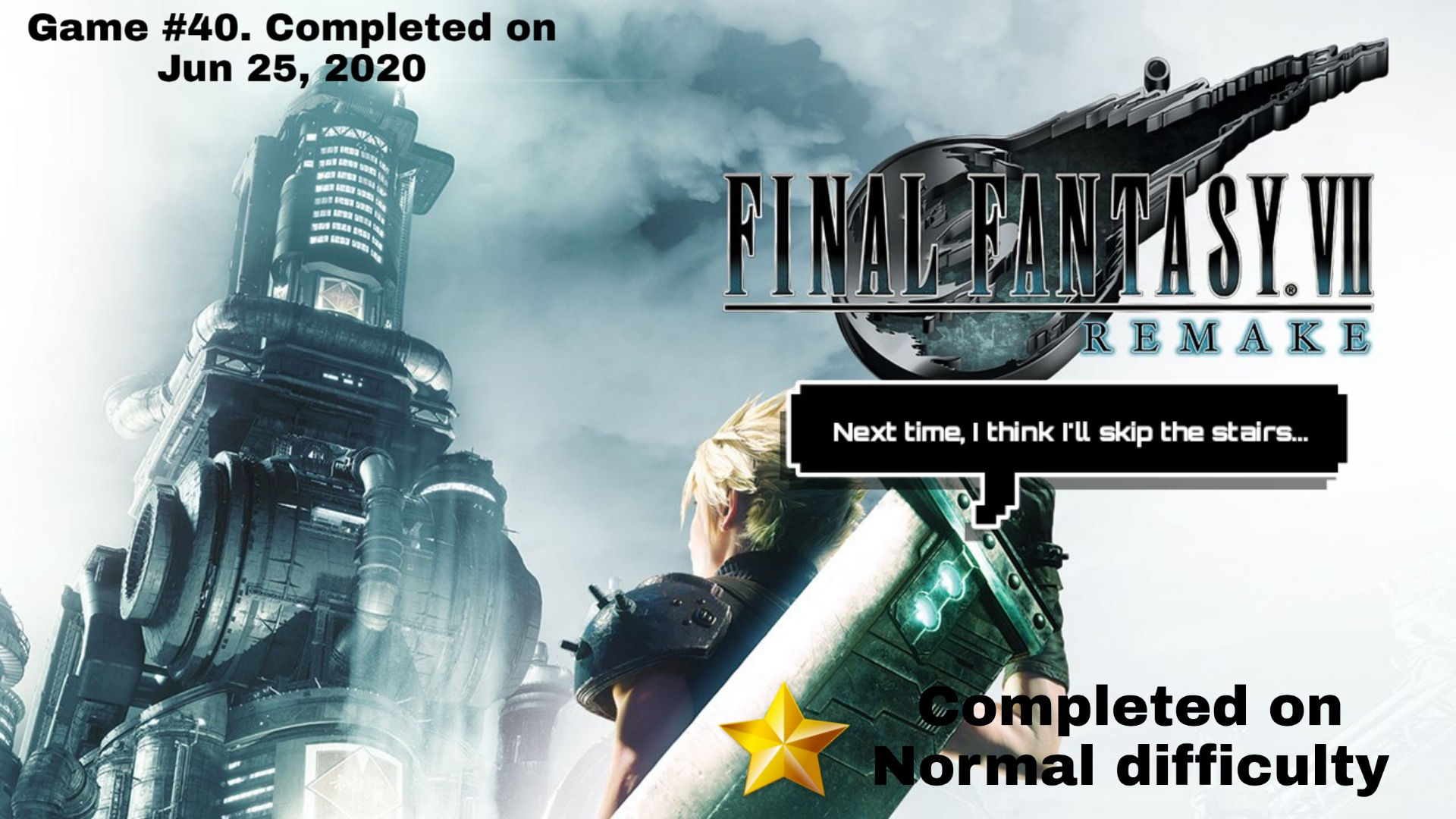
I’ve been playing Final Fantasy (FF) games/RPGs since the SNES era and while I was there for the original release of FFVII on the PS1 and remembered enjoying it as a kid, I wasn’t obsessed with the game like others were. I respect the game for what it was/what it did for the genre at the time, but I discovered other RPGs and franchises that became my new favorites as time moved forward, so to speak. While it most certainly opened the flood gates for more Japanese RPGs in the west, certain aspects of FFVII haven’t aged as well as I’d like to think. With that said, fans have been begging (demanding) for a remake of FFVII for well over two decades now, so here we are, in 2020, during a global pandemic, playing the stuff of dreams… sort of.
The biggest question(s) leading up to the game’s official announcement/release was how much of the remake was going to encompass the original game? FFVII is most notable for its near-future, industrialized metropolis known as Midgar, but it’s certainly a much larger game than what the first handful of hours would suggest. So, did Square Enix ever intend on recreating the PS1 version in its entirety? The answer, unfortunately, was a big, fat “no”. To no one’s surprise, the Final Fantasy VII Remake (FF7R) was only going to be an expanded/re-imagined take on the Midgar portions of the original game… and that’s exactly what this is (for better or worse). FF7R is a mostly faithful trip down memory lane, but with a few twists and liberties taken along the way.
The other concern most fans had was with how the battle system was going to be implemented. Surely, traditional-turn based games have no place in 2020 (which I disagree with), especially considering Square Enix’s recent affairs. A lot of players were worried that it would have been a combination of Kingdom Hearts and FFXV (the latter of which was a mess), so questions/concerns prior to release were most certainly valid. What we ended up receiving was a fairly decent compromise, however. FF7R is without a doubt, an action-RPG at its core, but there are still turn-based elements present. Battles can comprise of up to three playable characters, each with their own unique capabilities. Barret, for example, can easily destroy aerial enemies and Cloud is obviously better for more direct, aggressive enemies on the ground.
Regular attacks build up your traditional ATB bar, which allows you to perform abilities, use items or cast spells at the expense of a segment on your meter, which in turn freezes the combat in a spectacular display of particle effects. It’s a surprisingly decent battle system that encourages the player to switch between characters on the fly. Unfortunately, this isn’t immediately apparent to the player as some of the layered, more complex aspects of the battle system are not thoroughly explained. Weapons, accessories and Materia are back as well, which allow further customization options during battle. Weapons have skill-trees (which look similar to the Crystarium system from FFXIII) and can grant you passive stat bonuses or additional Materia slots, but only when said weapon is equipped. It’s certainly not my favorite battle system from a FF game, but it’s better than what FFXV offered.
One of the best aspects of FF7R was its characterization, however. While Cloud, Barret, Tifa and Aerith act/feel similar to their polygonal counterparts, the secondary members of the Avalanche crew; Jessie, Biggs and Wedge (otherwise known as eco-terrorists) were further fleshed-out and given actual personalities. There was one chapter in particular towards the beginning of the game that really stood out to me. In this chapter, you’re plan is to infiltrate an Shinra base, but you need an access card from Jessie’s parents’ house first. While you’re there, some members of Avalanche join Jessie’s mom for some pizza. It’s quite honestly something you would have seen from a Yakuza game; moments that ground the characters and make them feel more human, endearing and genuine. It’s a scene that probably wouldn’t have been effective in the original game, but it’s moments like this that sets the remake apart from anything else.
With that said, the re-imagining and scope of Midgar felt grand/impressive at first, but what’s actually explorable outside of the linear, chapter-based “dungeons”, sequences and set-pieces were extremely disappointing. A lot of people have criticized FFXIII over the years for being too linear, but at least the environments were colorful, vibrant and varied. Gran Pulse may have just been a large, arguably empty field of enemy encounters and secret boss fights, but if my memory serves correctly, it felt like a much larger space to explore than the few junkyards, tunnels and valleys of rubble at your disposal in FF7R. Perhaps the dilapidated pathways and claustrophobic spaces lend themselves to how suffocating the city feels to the citizens of Midgar, but outside of Aerith’s beautiful garden, the environments aren’t exactly spacious/welcoming. Outside of a chapter or two, I never felt like I understood when/where I could go to level-up or tinker with my Materia/equipment. The game is constantly moving forward (for better or worse).
Once I realized that the few areas in-between Aerith’s church and Wall Market were the only breathable areas to explore, so to speak, any highs I hit were met with some very low lows (and there were definitely plenty of moments that left me scratching my head and asking “why?”). The honeymoon period didn’t last very long, to say the least. I understand that Midgar is an industrialized city covered by a huge plate comprised of reactors, factories, neighborhoods and slums dividing its levels, but I wish the developers could have found a more interesting way to develop the city aesthetically/structurally. Perhaps its still too ambitious of a project because the hardware limitations are clearly present (those JPEG image backgrounds are tough on the eyes) despite the game looking gorgeous most of the time.
I also couldn’t stop thinking about the Yakuza games while I played this remake. If you’re familiar with the series, I sort of imagined or pictured a modern-day re-imagination of Midgar to feel more like Kamurocho, at least in terms of its liveliness, personality and density. I think most, if not all of the side-quests in FF7R range from being forgettable to just plain bad, too. There’s nothing even remotely close to capturing even the most minor of side-stories from Yakuza 0, such as the sub-story where you track down a thief who stole a video game for his estranged son, for example. Months after finishing the game, I can’t recall any side-quest outside of saving some cats, clearing out rat-like creatures and finding music disks for a little girl. The remake added some much appreciated world-building (like the giant artificial lighting/heating lamps that kept the slums bright and warm below), but the side content left a lot to be desired.
I have much more to say about the game, but I’ll likely save my remaining thoughts for my 2020 GOTY post. While I’m extremely critical of FF7R (given it’s pedigree and troubled development cycle, I think it’s only fair), I really did enjoy most of my time spent with the game. As someone who loves FF and RPGs alike, there’s a lot to admire about FF7R despite its (many) shortcomings. I’m looking forward to Square Enix delivering the rest of the game in 20XX, when democracy is dead and reploids rule the earth.
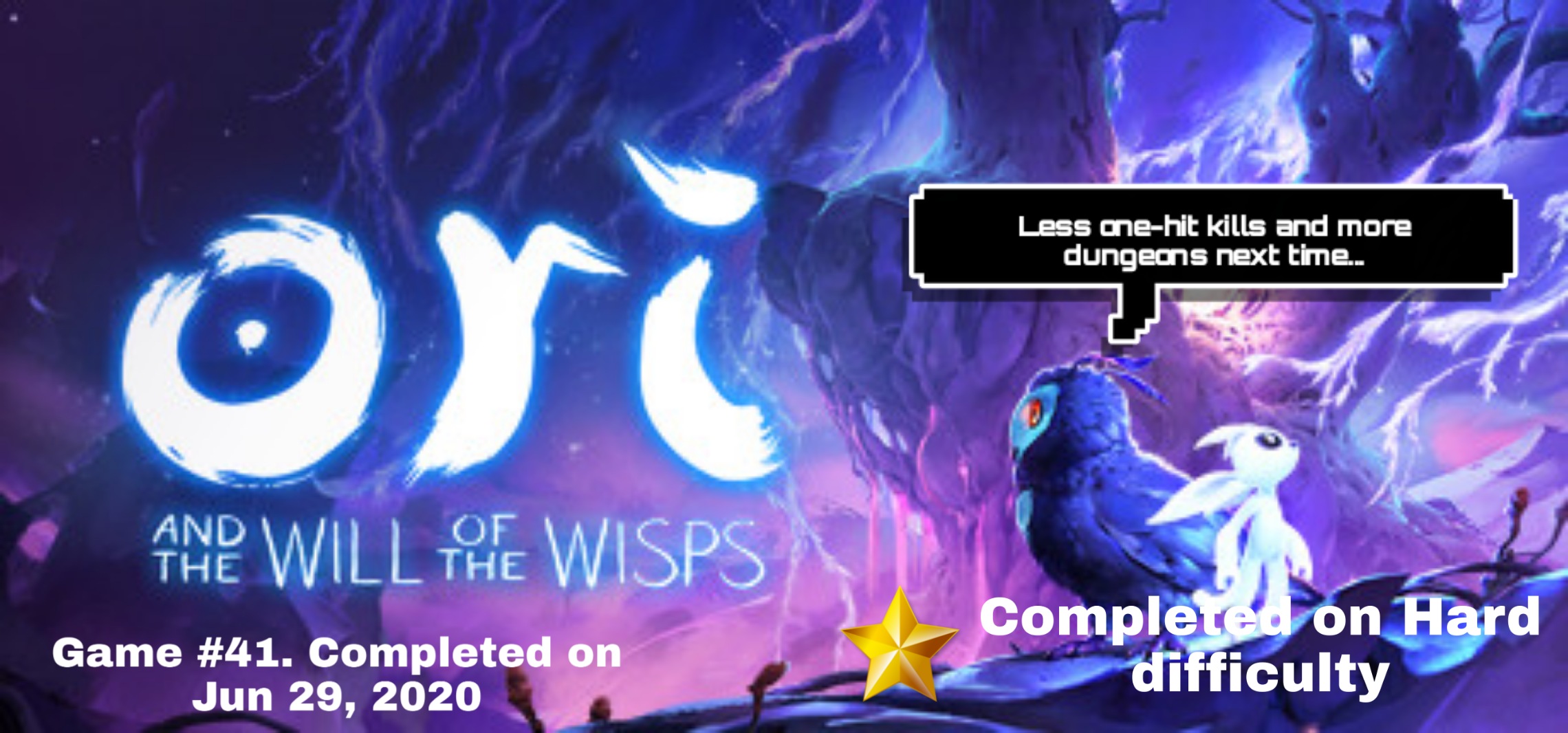
I liked Ori and the Blind Forest well enough (which you can read about here), but it wasn’t without its problems. The sequel, Ori and the Will of the Wisps, developed by Moon Studios, is a follow-up which takes place after the events of the original game. At first, I was having trouble getting into the game during the first few hours. The intro cinematic attempts to hit the same emotional highs that the first game provided, but it’s not as powerful. The original game was also mostly comprised of a jungle/forest with the standard fire and ice areas you’d expect from the genre. The sequel starts mostly the same with a dark, damp swamp and it didn’t feel as inspired as I was hoping it was going to be. Once I discovered the first major town, its respective dungeon and boss fight (something that was missing from the first game), my impression of the game completely flipped and I fell in love with it.
At a glance, Ori and the Will of the Wisps doesn’t look/play too differently from the first game, but there are small touches that certainly set it apart from its predecessor. Both Ori games have some of the best movement in a 2D platformer to date; the burrowing technique (which is new to the Will of the Wisps), the tried and true Bash maneuver from the first game or even the triple jump, each traversal ability gives you so much control/freedom over Ori’s movement. The new town hub, which you can restore over the course of the game by completing quests and such was a much needed/appreciated layer missing from the first game, too.
Clearly, Moon Studios has some of the finest environmental artists and animators in the business. Ori and the Blind Forest was beautiful, but somehow they’ve outdone themselves with the sequel. The areas are much more diverse and appropriately themed than the first game, too. There’s a pitch dark cavern infested with spiders, a wasteland ravaged by a giant sand worm and a tropical biome flooded by water (my favorite area), among other feasts for the eyes. At one point, you can see an abandoned water mill in the background from the starting area and once you restore the structure and you return to that same spot, you can see it moving/functional in the background. It’s little touches like this that make the game special.
Finally, I would be remiss if I didn’t mention Gareth Coker’s incredible soundtrack. I often found myself putting the controller down and just listening to the music as Ori sat there idle on the screen. It’s that good. I completed the game on Hard difficulty, but I haven’t gone back to 100% the game yet. I’ll likely revisit Ori and the Will of the Wisps once the Xbox One Series X update hits. It’s easily one of my favorite games of the year.
See you next quarter!
-Matty
3 Comments »